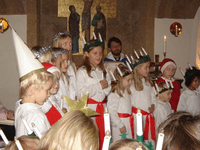Scandinavian Venezuelan
Scandinavian Venezuelan (Spanish: escandinavo-venezolano) is a Venezuelan person of full or partial Scandinavian ancestry, or a Scandinavian-born person residing in Venezuela.
| Regions with significant populations | |
|---|---|
| Caracas | |
| Languages | |
| Predominantly Spanish | |
| Religion | |
| Protestantism (especially Lutheranism) | |
| Related ethnic groups | |
| Other Venezuelan people, Danish people, Norwegian people, Swedish people, Finnish people, Icelandic people, Faroese people |
The Scandinavian settlement in Venezuela are almost unknown with little information about their colonization. It is believed that one of the first Scandinavian people to come to Venezuela were the Danish Protestant missionaries from the Alianza Escandinava Mission on 1890.[1][2] In 1938, former ex-president Eleazar López Contreras made a decree creating the Technical Institute of Immigration and Colonization, in order to organize and control the settlements where they would locate these groups from the European immigration to Venezuela. Among the first beneficiaries of this policy, it came 48 Danish families from northern Europe, composed of 2.780 people who were installed in Chirgua, with 26 selected Venezuelan families.[3][4][5][6][7][8][9][10]
After World War II, emigration from Finland to Latin America continued, but to a smaller degree than before. According to Finnish official statistics, about 500 emigrants left for Latin American countries. Venezuela became then a new country to Finnish emigration. In the course of time small Finnish colonies have sprung up within some of South America's major cities, especially in Buenos Aires, Sao Paulo, Rio de Janeiro and Caracas.[11]
Religion and culture

On October 1954, the Scandinavian community founded in Caracas, the Scandinavian Congregation (Spanish: Congregación Escandinava) with the help of Pastor Åke Kastlund. Later they founded the Lutheran Church of "La Resurrección" in La Castellana district, together with the German, Hungarian and Latvian Protestant communities.
Some of them celebrates Midsommar, which coincides with Venezuelan festivity of Fiesta de San Juan. It is celebrated with the traditional campfire, songs and dances around the midsommarstång.[12]
Notable people
- Eva Ekvall
- Eva Lisa Ljung
- Peter Bastiansen
- Thor Halvorssen Mendoza
- Thor Halvorssen Hellum
References
- Ayala Mora, Enrique (2008). Historia general de América Latina: Los proyectos nacionales latinoamericanos : sus instrumentos y articulación. 1870-1930. UNESCO. p. 262. ISBN 978-9233031562. Retrieved 6 September 2015.
- Ayerra Moreno, Jacinto (1980). Los protestantes en Venezuela. Quiénes son. Qué hacen. Caracas, Venezuela: Trípode.
- Betancourt, Rómulo (2007). Venezuela, política y petróleo (6º ed.). Caracas, Venezuela: Universidad Católica Andrés Bello. p. 497. ISBN 978-9800111482. Retrieved 7 September 2015.
- La Inmigración en Venezuela [película]: llegando de los inmigrantes daneses. Caracas, Venezuela: Instituto de Educación Audiovisual. 1940. Retrieved 7 September 2015.
- Montero Alcalá, Germán. "Chirgua". Pueblos de Venezuela. Retrieved 7 September 2015.
- "En 1948 y una vez terminada la II Guerra Mundial 763 inmigrantes europeos llegaron a Puerto Cabello". Notitarde. 5 January 1998. Retrieved 7 September 2015.
- Marques Sureda, Salomó; Martin Frenchilla, Juan José (2002). La labor educativa de los exiliados españoles en Venezuela. Caracas: Fondo Editorial de Humanidades y Educación (UCV). p. 160. ISBN 9789800019634. Retrieved 7 September 2015.
- De Veracochea, Ermila (8 March 1983). Colonias Agricolas en el siglo XIX (PDF). Caracas: Universidad Central de Venezuela. p. 325. Retrieved 7 September 2015.
- https://inmigracioneuropeaenvzlad1936a1961.blogspot.com Inmigración Europea en Venezuela
- Lameda Luna, Hernán (2014). Foundational Cycles of cities in Venezuela. Urban settlements from the colony to the twentieth century (in Spanish). Maracaibo: Revista Arbitrada de la Facultad de Arquitectura y Diseño de la Universidad del Zulia. p. 24. Retrieved 7 September 2015.
- Kero, Reino. "Migration from Finland 1866-1970". Genealogia. Retrieved 7 September 2015.
- "Congregación Escandinava". Aves de Palmas (in Spanish). Retrieved 7 September 2015.




